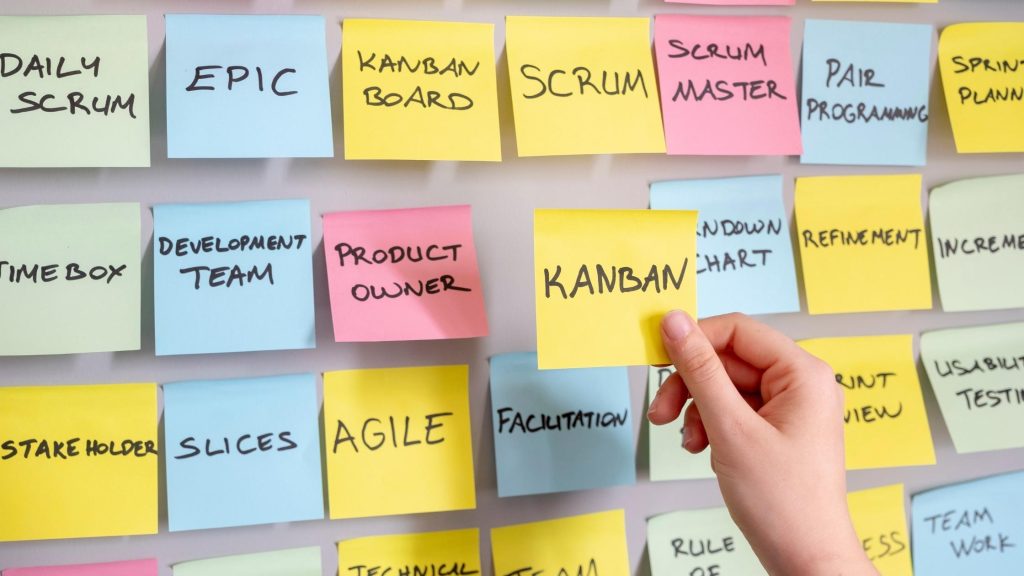Imagine a ship without a boatswain. The captain is there but the boatswain (who is constantly in contact with the crew, knows the nuances of the ship, and the individual characteristics of each crew member) isn’t. Similarly to a ship that will not go far without a commander who knows its strengths and weaknesses, a software development project will be doomed to fail without a flexible management system.
Agile methodology is by far the most effective way to manage a team and develop almost any software product. The value and high efficiency of this approach have been tested over time and are reflected in plenty of successfully completed projects.
In short, agile methodology in software development is an approach focused on continuous planning, that’s leniently responding to changes, maintaining a team spirit, and well-coordinated work of different teams working on one product.

The core values of an agile approach
- People and their effective interactions are more important than tools and processes
- Cooperation with the client is more important than dry negotiations within the framework of the contract
- Responding quickly to changes is more important than acting on a pre-planned plan
- A working and viable software product is more important than detailed documentation
There are several well-established and well-proven types of agile methodology on the market today. I will not list them all, but I will mention the 6 most popular and reliable ones, in my opinion.
Kanban
Translated from Japanese, kanban means a sign or a billboard. And really, looking at the format of this methodology, the kanban board visually resembles a signboard consisting of tasks put on sticky notes that are placed in different priority zones. The main goal of the Kanban methodology is to implement a ready-made and high-quality software product on time. The team working on the project is tightly united. Encouraging the pursuit of leadership is a fundamental part of the Kanban philosophy.
Scrum
The basic idea behind the Scrum methodology is similar to the old quote “When eating an elephant, take one bite at a time.” Scrum divides work into sprints (steps/stages) that last no more than 4 weeks. At the beginning of each sprint, all the participants of the development process clearly define the roles and tasks that they must complete before the end of the designated period. Daily meetings are another important part of the Scrum methodology, where participants discuss the progress of tasks, the difficulties that a particular team member faces, and how to solve them.
Feature-driven development – FDD
The name speaks for itself. This methodology is based on a system of functions and is divided into 5 stages: creating a general model > building a list of functions > planning for each function > creating function design > function development. The development of each model with its functions is strictly limited to two weeks.
Dynamic Systems Development Method – DSDM
The basic principles of DSDM are to never compromise on quality, to deliver projects on time, and all changes being reversible. Just like Scrum and FDD, it has clearly limited deadlines for completing stages – sprints.
Crystal
The Crystal methodology is based on an individual approach to problem-solving. The 2 core principles of Crystal are to use unique methods to deliver a unique project, and to find the best way to improve the overall development process. The main difference from other methodologies is that it has different frameworks for teams of different sizes. Crystal Clear is for teams of 1 to 6 people, Crystal Yellow is for 7-20 people, Crystal Orange is for 21-40 people, Crystal Red is for 40-80 people, Crystal Maroon is for 80-200 people, and Crystal Diamond & Sapphire are for huge projects which have potential risk to human life and health.
Extreme Programming – XP
XP is also part of the agile methodology but its main difference is that it focuses on the technical aspects of software product development. Code and testing in this methodology are more important than personal qualities and communicative interaction between project participants.

Conclusion
A flexible methodology allows you to organize and manage the development stages from the very creation of the idea to the release of the finished product. The choice of a specific methodology definitely depends on your team, the type of your product, and of course personal preferences.
ABNK Premium Systems‘ teams have been using agile methodologies for a long time, and we found it best to mix a few of these strategies to get the best results for our projects.





